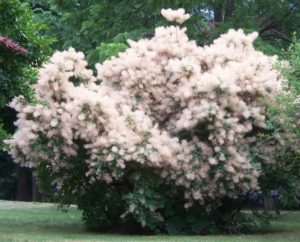Properly placed trees can add value to your property. They can provide shade to keep cooling costs down in the summer and provide a windbreak to keep heating costs down in the winter. Trees can provide privacy and year-round interest in the landscape.
 Smoke bush
Smoke bush
Young zone 4 tree selections may need a little extra protection to make it through the winter. It’s not uncommon for deer or rabbits to rub or chew on new saplings in fall and winter. Tree guards placed around the trunks of new trees can protect them from animal damage.
Experts argue about using tree guards for frost protection. On one hand, it is said that tree guards can protect a tree from frost damage and cracking by keeping the sun from thawing and warming the trunk. On the other hand, it’s believed that snow and ice can get beneath the tree guards causing cracks and damage. Unfortunately, with many cold hardy trees, especially maples, frost cracks are just part of growing trees in zone 4.
 Sunburst Honey Locust
Sunburst Honey Locust
Adding a layer of mulch around the root zone of young trees is perhaps the best winter protection. Do not pile the mulch up around the trunk, though because of mice. The mulch should be placed around the tree’s root zone and drip line in a donut shape.
OAKLEAF MOUNTAIN ASH
Upright, oval branching habit becomes denser and rounded with age. White flower clusters appearing in spring followed by showy reddish-orange berry like clusters. Foliage is dark green on upper surface with a white pubescence on undersides. This tree will tolerate poor soil and difficult growing conditions.
MANCHURIAN CHERRY
Prunus maackii, commonly called Manchurian cherry, Amur cherry or Amur chokecherry, is a graceful ornamental flowering cherry tree that typically grows 20-30’ (less frequently to 45’) tall with a dense, broad-rounded crown. It is native to Manchuria, Siberia and Korea. It is perhaps most noted for its attractive, exfoliating golden brown to russet bark. Fragrant white flowers in 6- to 10-flowered clusters (racemes) appear in April-May. Flowers are followed by small, glossy black cherries (1/4” diameter) which ripen in late summer. Fruits are used to make jams, jellies and juices. Elliptic to oblong, medium green leaves (to 4” long) have acuminate tips and serrate margins. Foliage turns undistinguished yellow in fall, often dropping early.
AMERICAN HOPHORNBEAM
American hophornbeam likes full sun or partial shade. It prefers slightly acidic soil and well-drained sites. It loves hilly areas, and in the wild, often grows in dry, even rocky soil. It is hardy in Zones 3 to 9. The tree should be mulched and watered until it is established. Although it is not sensitive to drought, it can’t survive flooding. It is also very sensitive to deicing salt. This tree has no serious pest problems, although it can be susceptible to chestnut borer if it is under stress. In the woods, it is one of the first trees to be defoliated by gypsy moth
AMUR MAPLE
Small tree; to 20′ tall x 20′ wide but often smaller which has upright vase in youth, becoming rounded or spreading with age growing at a medium growth rate. The species is sold in either clump (multi-stemmed) or tree (single-leader) form.
SERVICEBERRY
Apple Serviceberry is a hybrid between Amelanchier canadensis and Amelanchier laevis that grows 15 to 25 feet tall (Fig. 1). Multiple stems are upright and highly branched forming a dense shrub, or if properly pruned in the nursery, a small tree. It is superior to the species in that it suckers less and is adapted to a wide range of soils but tolerates some drought. This cultivar supposedly resists leaf spot better than the original hybrid. The main ornamental feature is the spectacular white flowers that are larger than those of other amelanchiers. The flowers are borne in early spring and are at first tinged with pink but later fade to white. The young leaves are purplish, and the fall color is red, yellow or orange. Edible fruit attracts birds. Well-adapted for planting along residential streets where there is plenty of soil space beneath power lines.
CORKSCREW WILLOW
Your Corkscrew Willow is also sometimes known as Dragon’s Claw for its gnarled, contorted limbs. Branches arise from the trunk at an acute angle and grow up almost parallel to the trunk before they curve back horizontally.
Corkscrew Willow’s appearance is at its best advantage in the winter when the foliage has fallen to reveal the one-of-a-kind branches. However, it also shines in the warmer months beginning with its pale-yellow catkins in spring.
As the catkins fade and the foliage develops, you’ll love the 4-inch long, lance-shaped leaves. The leaves contribute to your tree’s unconventional display with their curled nature. The green foliage, with white-tinted undersides, twirl in the slightest summer breeze.
In autumn the foliage turns to a lovely golden yellow hue for a last gasp of color before the tree’s winter appeal is revealed.
Corkscrew Willow grows 20-30 feet tall and develops a symmetrical, rounded crown. It is more drought tolerant than most willows and fast-growing. Corkscrew Willow prefers full sun, but you can still have one in part shade if you prefer. In fact, it’s relatively tolerant of most soils and conditions
